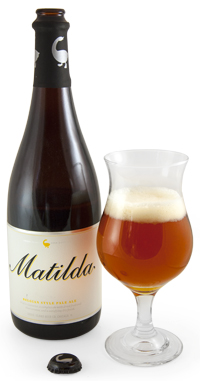
(Photo courtesy Merchant du Vin)
It would be safe to say that when bottles of the Belgian Trappist ale Orval started showing up behind bars and on shelves at liquor stores across the U.S. more than 30 years ago, American drinkers had tasted nothing like it.
A straightforward Belgian white ale Orval is not. Rather, the 6.9% dry-hopped Belgian pale ale, fermented with an ale yeast and bottle-conditioned with the yeast strain Brettanomyces, would have been a revelation for any unsuspecting palate. With its deep orange-amber color, half-inch foamy head, fruity and slightly acidic aroma, pronounced earthiness and tartness, and a very dry finish, it is a beer that demands attention.
“Retail sales of Orval was always the very, very leading edge of beer aficionados,” says Craig Hartinger, marketing director for Merchant du Vin, the importer for Orval. “There are many layers of depth and a lot of subtlety and some demanding flavors to Orval.”
Orval’s masterful complexity and drinkability have cemented it as a classic, particularly among brewing industry professionals like Allagash’s Rob Tod, Russian River’s Vinnie Cilurzo and New Belgium’s Kim Jordan, all of whom have cited Orval as a favorite beer.
“It is really the beacon of a particular style,” says Jordan, who praises its rocky, voluminous head, subtle Brettanomyces character and sturdiness of the malt combined with light peppery notes and a dry finish.
Like any enduring classic, Orval is also born of a legend. So the story goes: The widowed countess Matilda of Tuscany mistakenly dropped her wedding ring into a spring. Distraught, she prayed to God for its return and shortly thereafter a trout surfaced with the ring in its mouth. Matilda exclaimed, “Truly this place is a Val d’Or!” or “golden valley” and, overjoyed, she gave the land to the church, which built a monastery there, founded in 1070.
The brewery was established at the site of the Abbaye Notre Dame D’Orval in southern Belgium in 1930 and has produced just one packaged beer since then: Orval in its distinctive 11.2-ounce bottles with a trout, ring in mouth, on the label. (It also brews a lower-alcohol version of Orval, available on draft at the brewery and occasionally bottled.)
History may ground Orval, but it is how the beer changes in the bottle as the hops fade and the Brett consumes complex sugars, resulting in higher carbonation and a drier finish, that continues to captivate brewers and drinkers.
“I think of one of the things that stood out for me from one of the first times I tasted that beer years and years ago is the transformation of a beer with the Brettanomyces,” says David Logsdon, of Logsdon Farmhouse Ales in Hood River, Oregon. Logsdon brews a number of beers with Brett, including flagship Seizoen Bretta, which won the Gold Medal in the American Brett Ale category at the Great American Beer Festival in 2012.
“That’s the one thing I could take away from what Orval’s inspired me for, besides the style of beer that they brew, is the longevity the beer potentially has with that refermentation,” says Logsdon. “Most people, when they go into a bottle shop, they’re looking for the freshest beer possible. They don’t want an IPA that’s been sitting on a shelf for a year. Whereas when people go seeking our beers out, they look for the oldest beer possible, oftentimes.”
With Orval, it is possible to taste the transformation. At the renowned Belgian beer bar Monk’s Cafe in Philadelphia, drinkers can order Orval fresh (less than six months), six months or older, and a year or above.
It was the second Belgian beer Monk’s co-owner Tom Peters had ever tasted, 30 years ago at a bar in Brussels. It remains one of his all-time favorites.
“I love the integrity—they make one beer and one beer only,” he says. “Why mess with perfection? You don’t need to have three or four or five different beers as a monastery. You make one beer and it’s unique and no one else has duplicated it; it’s incredible.”
The following beers were reviewed by Heather Vandenengel.

Goose Island Matilda
ABV: 7.0%Tasting Notes: A tribute to Orval in style and name, as it is named for the legend of countess Matilda, who lost her ring only to have it returned by a trout. The aroma from a fresh bottle, also fermented with Brettanomyces, is earthy and bready. It pours a deep orange-golden hue similar to Orval with moderate carbonation and a slim head. A spicy yeastiness gives way to fruitiness and light floral hop notes, yielding a long and lingering dry finish.

Jolly Pumpkin Bam Bière
ABV: 4.5%Tasting Notes: Michigan’s Jolly Pumpkin is known for its oak-barrel-aged funky, wild ales. The sessionable farmhouse ale Bam Bière is subtle yet complex, dry-hopped and bottle-conditioned, similar to Orval, and pours hazy and golden with a sparkling, lively head that drops out fairly fast. A rich, yeasty aroma prevails, along with a bright and funky tartness. The body is mild and clean, with notes of barnyard funk, lemon zest and mild hop bitterness, and it finishes semi-dry.

Logsdon Seizoen Bretta
ABV: 8.0%Tasting Notes: Like Orval, Logsdon’s flagship ale is fermented with Brettanomyces and evolves as it ages in the bottle. At its midpoint, Logdson says, “It is a complex beer and the fruitiness tends to dominate. It evolves across the palate from start to finish, from that dry malt and subtle hops, to big fruit, to nice acidity.” As it ages, the Brett tends to reduce the malt and hop character, but a “nice, dry bitterness” remains. Logsdon prefers the bottle version to draft because it’s possible to carbonate higher.
Heather Vandenengel
Heather Vandenengel talks about beer on the Internet on Twitter at @heathervandy.

What ddo you think a bottle (capped and full) of Orval that is 35 years old worth today?